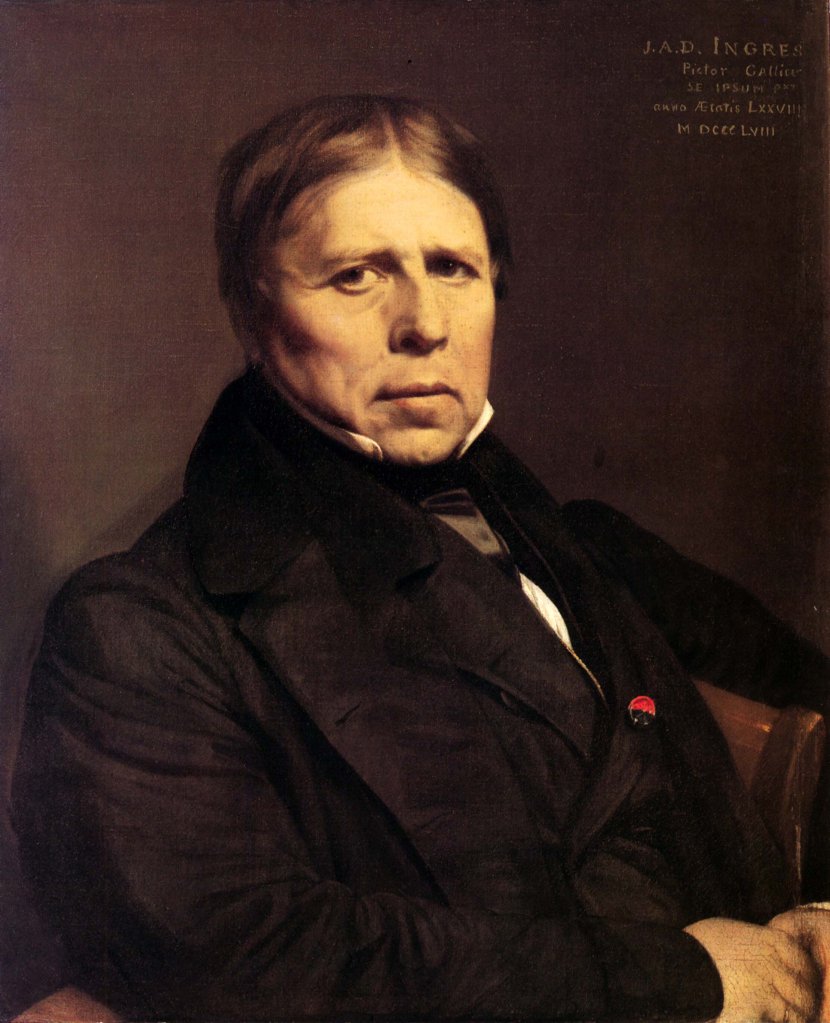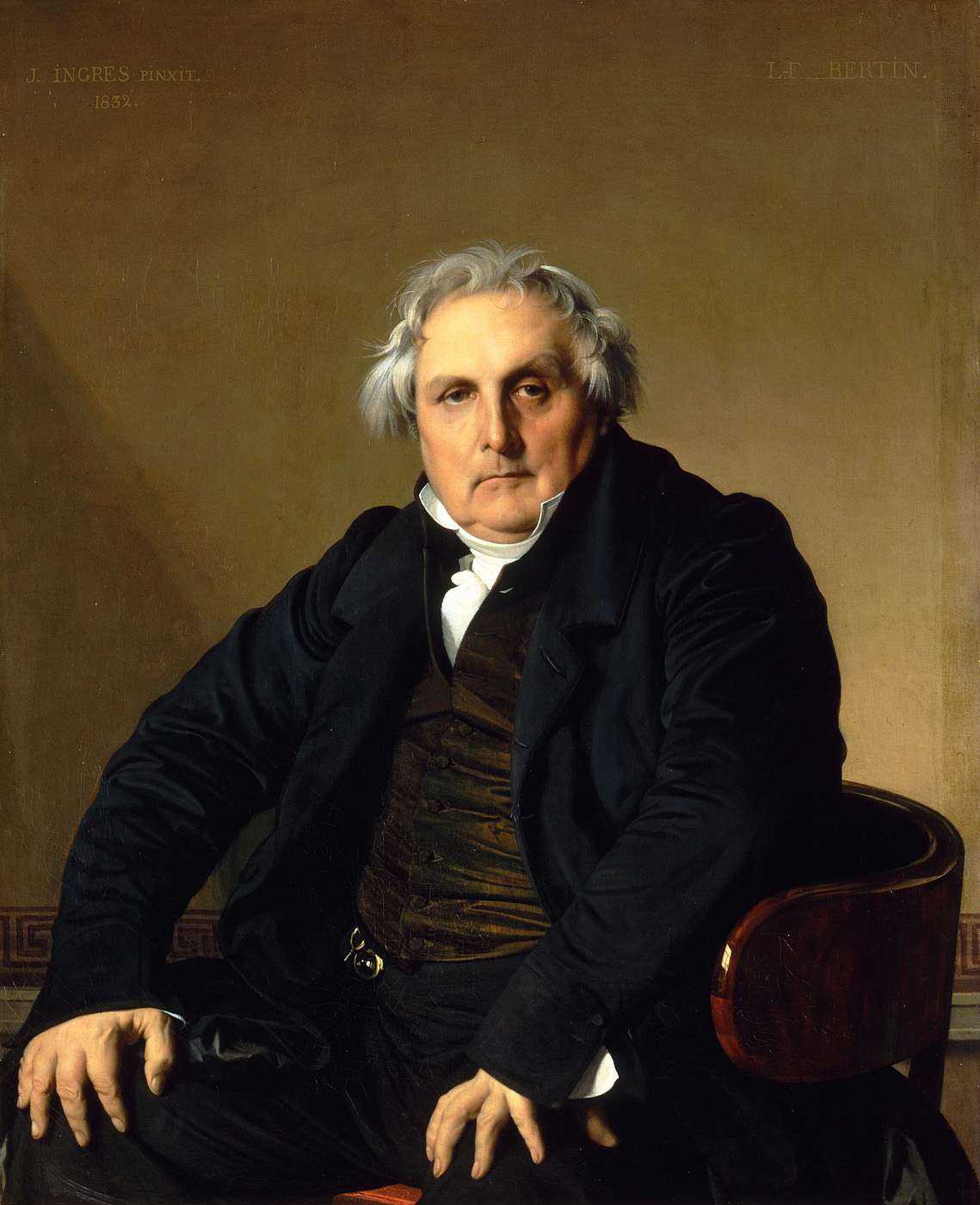|
Self-Portrait At Seventy-Eight (Ingres)
''Self-Portrait at Seventy-Eight'' is an 1858 oil-on-canvas painting by the French Neoclassical artist Jean-Auguste-Dominique Ingres. It is one of the last of his many portraits, which he had always regarded as bothersome distractions from his true calling, history painting. The painting measures 24 3/8 x 20 1/8 inches (62 x 51 cm) and is in the Uffizi Gallery, Florence. The self-portrait is renowned for its honest treatment of the physical effects of old age. Ingres' expression is foreboding and intense, and he is tightly wrapped in stiff military like clothes. The work was painted at a point when Ingres, owing to age, could no longer commit to society portraits, which typically took him 4-5 years to complete. Ingres was to live a further nine years, dying on 14 January 1867, aged 86. History In 1839 the director of the Uffizi, Antonio Ramirez di Montalvo, sent Ingres a letter requesting the donation of a painting of himself for the museum's gallery of self-portraits of great a ... [...More Info...] [...Related Items...] OR: [Wikipedia] [Google] [Baidu] |
Portraits By Jean-Auguste-Dominique Ingres
A portrait is a painting, photograph, sculpture, or other artistic representation of a person, in which the face and its expressions are predominant. The intent is to display the likeness, personality, and even the mood of the person. For this reason, in photography a portrait is generally not a snapshot, but a composed image of a person in a still position. A portrait often shows a person looking directly at the painter or photographer, in order to most successfully engage the subject with the viewer. History Prehistorical portraiture Plastered human skulls were reconstructed human skulls that were made in the ancient Levant between 9000 and 6000 BC in the Pre-Pottery Neolithic B period. They represent some of the oldest forms of art in the Middle East and demonstrate that the prehistoric population took great care in burying their ancestors below their homes. The skulls denote some of the earliest sculptural examples of portraiture in the history of art. Historical portraitur ... [...More Info...] [...Related Items...] OR: [Wikipedia] [Google] [Baidu] |
Robert Rosenblum
Robert Rosenblum (July 24, 1927 – December 6, 2006) was an American art historian and curator known for his influential and often irreverent scholarship on European and American art of the mid-eighteenth to 20th centuries. Biography Rosenblum was born in New York City and studied art history at Queens College and Yale University and, in 1956, received his Ph.D. from New York University's Institute of Fine Arts. Rosenblum's many publications include ''Cubism and Twentieth Century Art'' (1960), ''Transformations in Late Eighteenth Century Art'' (1967), ''Modern Painting and the Northern Romantic Tradition: Friedrich to Rothko'' (1973), and ''Nineteenth Century Art'' (co-authored with H.W. Janson, 1984). However, he is perhaps best known for his innovations in curatorial practice, such as his inclusion of non-canonical works and his rejection of standard chronological ordering. Rosenblum held teaching positions at Princeton University, the University of Michigan, Yale University, ... [...More Info...] [...Related Items...] OR: [Wikipedia] [Google] [Baidu] |
Royal Museum Of Fine Arts Antwerp
The Royal Museum of Fine Arts Antwerp ( Dutch: ''Koninklijk Museum voor Schone Kunsten Antwerpen'', ''KMSKA'') is a museum in Antwerp, Belgium, founded in 1810, that houses a collection of paintings, sculptures and drawings from the fourteenth to the twentieth centuries. This collection is representative of the artistic production and the taste of art enthusiasts in Antwerp, Belgium and the Northern and Southern Netherlands since the 15th century. The neoclassical building housing the collection is one of the primary landmarks of the Zuid district of Antwerp. The majestic building was designed by Jean-Jacques Winders (1849–1936) and Frans Van Dijk (1853–1939), built beginning in 1884, opened in 1890, and completed in 1894. Sculpture on the building includes two bronze figures of Pheme with horse-drawn chariots by sculptor Thomas Vincotte, and seven rondel medallions of artists that include Boetius à Bolswert, Frans Floris, Jan van Eyck, Peter Paul Rubens, Quentin ... [...More Info...] [...Related Items...] OR: [Wikipedia] [Google] [Baidu] |
Fogg Art Museum
The Harvard Art Museums are part of Harvard University and comprise three museums: the Fogg Museum (established in 1895), the Busch-Reisinger Museum (established in 1903), and the Arthur M. Sackler Museum (established in 1985), and four research centers: the Archaeological Exploration of Sardis (founded in 1958), the Center for the Technical Study of Modern Art (founded in 2002), the Harvard Art Museums Archives, and the Straus Center for Conservation and Technical Studies (founded in 1928). The three museums that constitute the Harvard Art Museums were initially integrated into a single institution under the name Harvard University Art Museums in 1983. The word "University" was dropped from the institutional name in 2008. The collections include approximately 250,000 objects in all media, ranging in date from antiquity to the present and originating in Europe, North America, North Africa, the Middle East, South Asia, East Asia, and Southeast Asia. The main building contains of ... [...More Info...] [...Related Items...] OR: [Wikipedia] [Google] [Baidu] |
Portrait Of Madame Ingres
''Portrait of Madame Ingres'' is a late period oil on canvas painting by the French Neoclassical artist Jean-Auguste-Dominique Ingres, completed in 1859. Depicting his second wife Delphine Ramel (he was widowed in 1849),Tinterow, 433 it is Ingres' final painted portrait, apart from two self-portraits. It was probably painted to accompany Ingres's self-portrait of the same year, now in the Fogg Art Museum The Harvard Art Museums are part of Harvard University and comprise three museums: the Fogg Museum (established in 1895), the Busch-Reisinger Museum (established in 1903), and the Arthur M. Sackler Museum (established in 1985), and four research ..., Boston. . Harvard College, 2016. Retrieved 23 September 2017 [...More Info...] [...Related Items...] OR: [Wikipedia] [Google] [Baidu] |
Rembrandt
Rembrandt Harmenszoon van Rijn (, ; 15 July 1606 – 4 October 1669), usually simply known as Rembrandt, was a Dutch Golden Age painter, printmaker and draughtsman. An innovative and prolific master in three media, he is generally considered one of the greatest visual artists in the history of art and the most important in Dutch art history.Gombrich, p. 420. Unlike most Dutch masters of the 17th century, Rembrandt's works depict a wide range of style and subject matter, from portraits and self-portraits to landscapes, genre scenes, allegorical and historical scenes, biblical and mythological themes and animal studies. His contributions to art came in a period of great wealth and cultural achievement that historians call the Dutch Golden Age, when Dutch art (especially Dutch painting), whilst antithetical to the Baroque style that dominated Europe, was prolific and innovative. This era gave rise to important new genres. Like many artists of the Dutch Golden Ag ... [...More Info...] [...Related Items...] OR: [Wikipedia] [Google] [Baidu] |
Neoclassicism
Neoclassicism (also spelled Neo-classicism) was a Western cultural movement in the decorative and visual arts, literature, theatre, music, and architecture that drew inspiration from the art and culture of classical antiquity. Neoclassicism was born in Rome largely thanks to the writings of Johann Joachim Winckelmann, at the time of the rediscovery of Pompeii and Herculaneum, but its popularity spread all over Europe as a generation of European art students finished their Grand Tour and returned from Italy to their home countries with newly rediscovered Greco-Roman ideals. The main Neoclassical movement coincided with the 18th-century Age of Enlightenment, and continued into the early 19th century, laterally competing with Romanticism. In architecture, the style continued throughout the 19th, 20th and up to the 21st century. European Neoclassicism in the visual arts began c. 1760 in opposition to the then-dominant Rococo style. Rococo architecture emphasizes grace, ornamen ... [...More Info...] [...Related Items...] OR: [Wikipedia] [Google] [Baidu] |
Raphael
Raffaello Sanzio da Urbino, better known as Raphael (; or ; March 28 or April 6, 1483April 6, 1520), was an Italian painter and architect of the High Renaissance. His work is admired for its clarity of form, ease of composition, and visual achievement of the Neoplatonic ideal of human grandeur. Together with Leonardo da Vinci and Michelangelo, he forms the traditional trinity of great masters of that period. His father was court painter to the ruler of the small but highly cultured city of Urbino. He died when Raphael was eleven, and Raphael seems to have played a role in managing the family workshop from this point. He trained in the workshop of Perugino, and was described as a fully trained "master" by 1500. He worked in or for several cities in north Italy until in 1508 he moved to Rome at the invitation of the pope, to work on the Vatican Palace. He was given a series of important commissions there and elsewhere in the city, and began to work as an architect. He was ... [...More Info...] [...Related Items...] OR: [Wikipedia] [Google] [Baidu] |
Portrait Of Monsieur Bertin
''Portrait of Monsieur Bertin'' is an 1832 oil on canvas painting by Jean-Auguste-Dominique Ingres. It depicts Louis-François Bertin (1766–1841), the French writer, art collector and director of the pro-royalist ''Journal des débats''. Ingres completed the portrait during his first period of success; having achieved acclaim as a history painter, he accepted portrait commissions with reluctance, regarding them as a distraction from more important work. Bertin was a friend and a politically active member of the French upper-middle class. Ingres presents him as a personification of the commercially minded leaders of the liberal reign of Louis Philippe I. He is physically imposing and self-assured, but his real-life personality shines through – warm, wry and engaging to those who had earned his trust. The painting had a prolonged genesis. Ingres agonised over the pose and made several preparatory sketches. The final work faithfully captures the sitter's character,Boime (2 ... [...More Info...] [...Related Items...] OR: [Wikipedia] [Google] [Baidu] |







